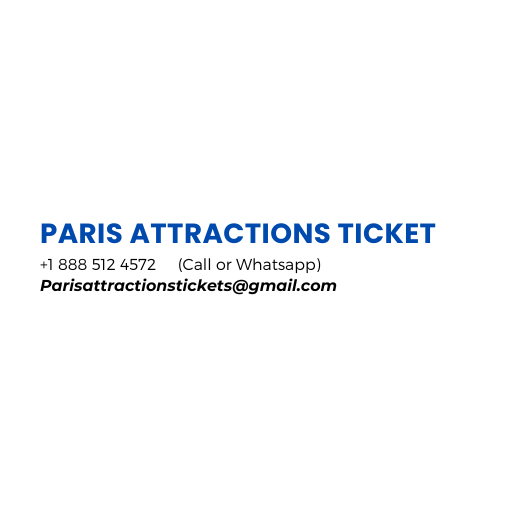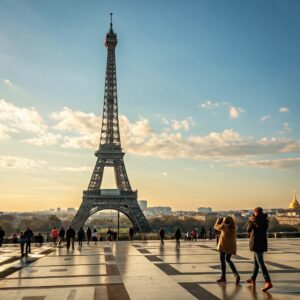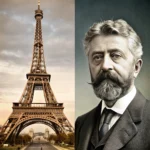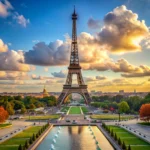Understanding the Iconic Hue of Paris’s Landmark
The Eiffel Tower is one of the most instantly recognizable landmarks in the world, towering over Paris with its elegant iron lattice structure. While much has been written about the tower’s engineering, history, and cultural significance, one aspect that often piques the curiosity of visitors is its color. What is the true color of the Eiffel Tower, and how has it changed over time? This article takes a deep dive into the history of the Eiffel Tower’s color, its significance, and the process of keeping it looking stunning for millions of visitors each year.
The Current Colour of the Eiffel Tower: Eiffel Tower Brown
The Eiffel Tower is painted in a distinctive shade called “Eiffel Tower Brown” (also referred to as “bronze”), a rich and warm hue with tones ranging from light brown to gold. This unique color was specifically chosen to complement the tower’s iron structure while blending harmoniously with the surrounding environment of Paris. The color has been a defining feature of the tower for decades and helps it stand out against the skyline.
The shade of Eiffel Tower Brown can sometimes appear slightly different depending on the time of day or the weather, creating a dynamic visual effect. In daylight, the color can look lighter and warmer, while during the evening or under cloudy skies, it may appear darker or more subdued. This makes the Eiffel Tower a striking subject of photography at all times of the day.
Why Was Eiffel Tower Brown Chosen?
When the Eiffel Tower was first constructed in 1887, the choice of its color was not as deliberate as it may seem. Originally, the structure was a more neutral tone that closely resembled the natural color of the iron used in its construction. However, as the tower aged and withstood the elements, it became apparent that regular maintenance and protection were necessary to keep it in optimal condition.
The decision to use Eiffel Tower Brown (bronze) came about during the early 20th century, as it offered several advantages:
- Aesthetic Balance: The warm brown tone allows the tower to blend with both the Parisian skyline and the natural surroundings while maintaining a prominent visual impact. Its color highlights the intricate latticework of the iron structure.
- Protection Against the Elements: The color is part of an important preservation strategy. The paint helps protect the tower from corrosion caused by rain, wind, and humidity. This is especially important because the Eiffel Tower is exposed to harsh weather conditions year-round.
- Historical Significance: As the Eiffel Tower has become a symbol of France, the chosen color also reflects the country’s history and engineering achievements. It remains timeless and classic, just like the tower itself.
How Often Is the Eiffel Tower Painted?
The Eiffel Tower is painted approximately every seven years to maintain its appearance and structural integrity. Over time, the iron lattice naturally corrodes due to exposure to the elements, making periodic painting a necessity.
During this process, the Eiffel Tower is stripped of its old paint and repainted with 60 tons of new paint. It typically takes 18 months to complete the entire job, and the work is carried out by a team of skilled painters, many of whom climb the tower to apply the layers of paint by hand. This meticulous process ensures that the tower continues to shine brightly and remain protected for future generations.
Interestingly, the Eiffel Tower does not remain the same color for its entire lifespan. In the past, it has been painted in several different shades, including Venetian Red, Chestnut Brown, and Ochre Yellow. The current bronze hue, however, has been the standard since 1968.
The Painting Process: A Monumental Task
The task of repainting the Eiffel Tower is a monumental one due to the size and complexity of the structure. The tower’s total surface area is about 250,000 square feet, requiring an extensive amount of preparation and labor to complete the job. Here is a brief look at how the Eiffel Tower is repainted:
- Preparation: The tower is thoroughly cleaned to remove any dirt, debris, and old layers of paint. This is done using a combination of scraping and sandblasting to ensure the surface is smooth and free from imperfections.
- Priming and Coating: Several layers of primer are applied to the structure to prepare it for the actual paint. Afterward, the Eiffel Tower Brown paint is applied in multiple layers to ensure full coverage and protection against the elements.
- Work From the Top Down: The painting process begins at the top of the tower and works downward. Painters use a special scaffolding system and harnesses to safely apply the paint, even in hard-to-reach areas.
- Time and Care: The entire process typically takes 15-18 months, and each part of the tower requires careful attention to detail. The Eiffel Tower remains open during the painting process, so visitors can still enjoy the views, though some areas may be temporarily closed for safety reasons.
The Eiffel Tower’s Colour Throughout History
Since its construction in 1889, the Eiffel Tower has undergone several changes in color. The original color was a red-ochre tone, reflecting the iron’s natural color. Over the years, different hues were tried, including Venetian Red in the early 1900s and Chestnut Brown in the 1950s. However, the bronze shade that is used today became the signature color in 1968.
The Eiffel Tower’s paint color is part of the ongoing efforts to preserve the monument’s structural integrity while also honoring its artistic legacy. Its distinctive brownish-golden tone helps to set it apart from other landmarks in Paris and ensures that it remains an iconic part of the city’s skyline.
Does the Eiffel Tower Ever Change Colour for Special Occasions?
While the Eiffel Tower is consistently painted in its signature bronze color, there have been instances when the monument has been illuminated in different colors for special occasions. For example, the tower is often lit up in blue for significant European Union celebrations or special events, and it sometimes features color-changing lights to mark holidays or commemorate certain global events. These light displays add another layer of beauty to the already stunning structure.
Conclusion: The Timeless Beauty of the Eiffel Tower’s Colour
The Eiffel Tower continues to capture the hearts of millions around the world, and its timeless color plays a big part in why it remains such a beloved icon of Paris. From its bronze hue that compliments the iron lattice to the ongoing efforts to preserve its beauty, the color of the Eiffel Tower reflects the structure’s elegance and enduring cultural significance.
As you visit this monumental landmark, keep in mind the years of care and attention that go into maintaining its stunning appearance, ensuring that it will continue to stand tall and proud for generations to come.
Frequently Asked Questions About what color is the Eiffel Tower
1. When was the Eiffel Tower built?
The Eiffel Tower was constructed between 1887 and 1889 and was completed in time for the 1889 Exposition Universelle (World’s Fair). It was designed by Gustave Eiffel and originally intended to be a temporary structure, but it has become one of the most enduring symbols of France.
2. How tall is the Eiffel Tower?
The Eiffel Tower stands at a towering height of 330 meters (1,083 feet), including its antenna. It was the tallest man-made structure in the world until the completion of the Chrysler Building in New York City in 1930.
3. How many floors does the Eiffel Tower have?
The Eiffel Tower has three levels accessible to the public. The first and second floors house restaurants, shops, and exhibition spaces, while the third floor, the summit, offers panoramic views of Paris. There is also an antenna at the very top.
4. How much does it cost to visit the Eiffel Tower?
The cost to visit the Eiffel Tower varies depending on the level you want to access. Tickets range from €10.50 for access to the second floor using the stairs to €26.10 for a ticket to the summit. There are also discounts available for children, students, and residents of the European Union.
5. What is the Eiffel Tower made of?
The Eiffel Tower is primarily constructed from wrought iron, which gives it its distinctive look and allows it to be both strong and lightweight. The structure weighs approximately 10,100 tons.
6. Why was the Eiffel Tower built?
The Eiffel Tower was originally constructed as the centerpiece for the 1889 Exposition Universelle (World’s Fair), which was held to celebrate the 100th anniversary of the French Revolution. It was designed to showcase French engineering and technological prowess.
7. Can you go to the top of the Eiffel Tower?
Yes, you can go to the top of the Eiffel Tower. Visitors can reach the summit via a glass-walled elevator or, if you prefer a bit of a challenge, climb the stairs to the second floor and take the elevator to the top from there.
8. How long does it take to visit the Eiffel Tower?
A visit to the Eiffel Tower typically takes 2 to 3 hours. This includes the time spent waiting in line (if you don’t purchase tickets in advance), exploring the first and second floors, and enjoying the breathtaking views from the summit.
9. Why is the Eiffel Tower painted every seven years?
The Eiffel Tower is painted every seven years to protect it from rust and to preserve its beauty. The iron structure is exposed to the elements, and painting helps prevent corrosion. The tower requires about 60 tons of paint for each coat, and the painting process takes around 18 months.
10. Who designed the Eiffel Tower?
The Eiffel Tower was designed by Gustave Eiffel, a French civil engineer, along with his company. The actual architectural design was done by Maurice Koechlin and Émile Nouguier, two engineers who worked for Eiffel.
11. Why is the Eiffel Tower so important?
The Eiffel Tower is a symbol of French innovation, engineering excellence, and artistic achievement. It is also a major tourist attraction, drawing millions of visitors each year, and is a symbol of the city of Paris and France as a whole.
12. Is the Eiffel Tower a UNESCO World Heritage Site?
Yes, the Eiffel Tower is part of the UNESCO World Heritage Site designation for the city of Paris. It is considered an outstanding example of 19th-century engineering and is a significant cultural and historical monument.
13. Can you visit the Eiffel Tower at night?
Yes, the Eiffel Tower is open in the evening and offers a stunning view of Paris lit up at night. The tower itself sparkles every hour on the hour after sunset for about five minutes, creating a magical spectacle for visitors.
14. How many visitors does the Eiffel Tower receive each year?
The Eiffel Tower is one of the most visited paid monuments in the world, with over 7 million visitors annually. Its popularity continues to grow, making it a must-see attraction for anyone visiting Paris.
15. What is the Eiffel Tower’s color?
The Eiffel Tower is painted in a color known as “Eiffel Tower Brown”, a bronze hue that complements its iron structure and helps it blend harmoniously with the Parisian skyline. This color was carefully selected to highlight the tower’s architectural features.



